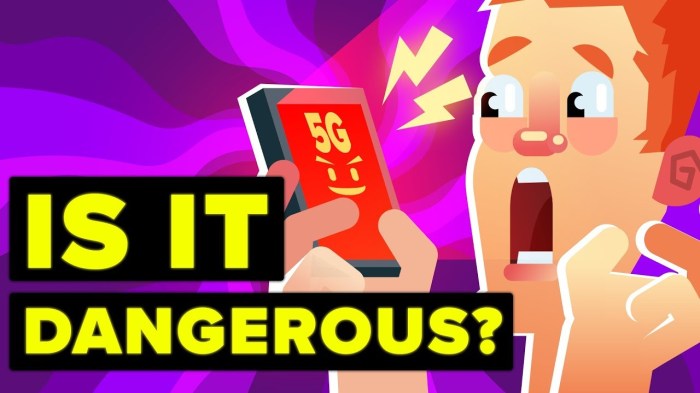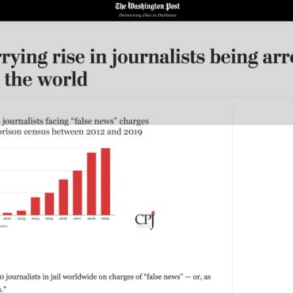5G dangerous or it safe? This question is buzzing around the world, as new wireless technology rapidly transforms our lives. Concerns about potential health risks are rising alongside the deployment of 5G networks. This in-depth exploration examines the scientific evidence, public perceptions, regulatory measures, and potential health effects to help us understand the complexities surrounding this crucial topic.
We’ll look at the science behind the claims, examine the fears and hopes, and analyze the regulatory response to this new era of wireless communication.
From the intricate workings of biological mechanisms potentially impacted by 5G radiation to the public’s anxieties about the unknown, this exploration uncovers a wealth of information about the safety and potential dangers of 5G. We’ll also compare 5G to previous generations of wireless technologies, analyzing radiation levels and potential health risks. This comprehensive analysis will ultimately aim to provide a clear understanding of the current state of knowledge on 5G safety.
Scientific Evidence

The quest to understand the potential health effects of 5G technology hinges on robust scientific evidence. While the technology promises significant advancements, concerns regarding its impact on human health remain a focal point. This section delves into the existing scientific literature, analyzing the methodologies, findings, and limitations of research on 5G safety.
Research Methodologies
The scientific community employs diverse methodologies to investigate the potential health effects of 5G. Studies vary significantly in their design, making direct comparisons challenging. Some studies use epidemiological approaches, examining large populations exposed to 5G signals to identify potential correlations between exposure and health outcomes. Others employ laboratory experiments, subjecting biological systems to controlled 5G radiation exposures to investigate potential cellular-level impacts.
Epidemiological Studies
Epidemiological studies, observing large populations, aim to identify potential links between 5G exposure and health issues. These studies often face challenges in isolating 5G exposure from other environmental factors and lifestyle choices that might influence health. Variability in exposure levels and duration within the study populations also complicates data analysis. Furthermore, the relatively short time frame of widespread 5G deployment presents a hurdle for identifying long-term health effects.
Laboratory Studies
Laboratory studies, using controlled environments, offer a means to isolate 5G exposure and investigate potential biological mechanisms. However, these studies often use cell cultures or animal models, which may not fully reflect the complexity of human biology. Extrapolating findings from these models to human health outcomes necessitates caution.
Key Findings
To date, no conclusive evidence definitively links 5G exposure to adverse health effects in humans. Some studies suggest potential effects, but these are often debated due to methodological limitations. Crucially, the lack of consistent, well-replicated findings in the existing research is a significant limitation.
Methodological Breakdown of Safety/Danger Claims
A critical review of studies claiming 5G is either safe or dangerous reveals variations in methodologies. Studies claiming safety often employ limited sample sizes, short study durations, or lack robust control groups, hindering their generalizability. Conversely, studies claiming potential dangers may not account for confounding variables or employ methodologies that are not easily replicable.
Limitations of Current Research
The current research on 5G safety faces significant limitations. The relatively short time frame since widespread 5G deployment makes long-term effects difficult to assess. The complexity of human biology and interactions with electromagnetic fields complicates research designs. Additionally, the lack of standardized exposure measurement protocols across studies creates inconsistencies and challenges in comparing findings.
Biological Mechanisms
The scientific community continues to explore potential biological mechanisms that might be impacted by 5G radiation. These include effects on DNA, cell membranes, and ion channels, although specific mechanisms are not fully understood and require further investigation.
While the 5G debate rages on about its potential health risks, it’s fascinating to see how technology is rapidly evolving. For example, checking out the latest BBC Micro:bit computer pre-order price, bbc micro bit computer pre order price , gives you a glimpse into the future of learning and innovation. Ultimately, whether 5G is safe or not remains a subject of ongoing research and discussion.
Comparison of Frequency Ranges
| Technology | Frequency Range (GHz) |
|---|---|
| 5G | 0.5 – 26.5 |
| 4G LTE | 0.7 – 2.6 |
| Wi-Fi | 2.4, 5 |
| Bluetooth | 2.4 |
The table above highlights the frequency ranges of various wireless technologies, including 5G. Understanding these ranges is essential for assessing potential exposure levels and their corresponding biological effects. Comparison across technologies reveals overlapping and distinct frequency bands.
Public Perception and Concerns

Public perception of 5G technology is a complex mix of excitement and apprehension. While the scientific community overwhelmingly supports the safety of 5G, concerns from the general public remain a significant hurdle. These concerns are often rooted in a lack of understanding of the technology and, unfortunately, fueled by misinformation. Addressing these public anxieties is crucial for fostering trust and enabling the widespread adoption of 5G.The public’s understanding of 5G is often shaped by the media portrayal of the technology.
The 5G debate rages on, with some worried about potential health risks. While the science isn’t fully conclusive, it’s worth noting that a good posture while using your tablet or phone is essential, no matter the technology. Grab this height adjustable tablet stand for just 11 grab this height adjustable tablet stand for just 11 to improve your comfort and potentially reduce strain on your neck and back.
Ultimately, more research is needed to definitively answer the 5G safety question.
Some news outlets have presented potentially misleading information, creating a climate of uncertainty and fear. This has led to the proliferation of conspiracy theories and unsubstantiated claims, which, in turn, have influenced public opinion. It is essential to differentiate between the verifiable facts surrounding 5G and the unfounded anxieties that sometimes dominate the conversation.
Common Public Concerns Regarding 5G
Public concerns about 5G frequently center on potential health risks. These anxieties often stem from a perceived link between radiofrequency radiation emitted by 5G towers and various health problems.
- Potential health impacts: A significant concern is the potential for long-term health effects from exposure to radiofrequency electromagnetic fields (RF-EMFs). Concerns include cancer, neurological disorders, and other illnesses. While some studies suggest potential correlations, rigorous scientific evidence remains inconclusive. This uncertainty contributes to the public’s apprehension.
- Lack of transparency and regulation: Concerns exist about the lack of transparency surrounding 5G deployment and potential regulatory oversight. The perceived speed and scale of 5G rollout have sometimes raised questions about the thoroughness of safety measures and the potential for unforeseen consequences.
- Misinformation and conspiracy theories: The internet has become a breeding ground for misinformation and conspiracy theories related to 5G. These narratives often link 5G technology to a range of health issues, frequently without any scientific basis.
Sources of Misinformation
Misinformation about 5G safety frequently originates from various sources. These sources include social media, certain news outlets, and individuals with vested interests.
- Social media: The rapid spread of information on social media can facilitate the dissemination of misinformation, especially if it resonates with existing anxieties or concerns. The lack of fact-checking and verification on these platforms can amplify false claims.
- Certain news outlets: Sensationalized reporting or articles lacking scientific rigor can unintentionally contribute to the spread of misinformation about 5G. A tendency to emphasize potential risks, rather than balanced perspectives, can be misleading.
- Individuals with vested interests: In some cases, individuals or groups with vested interests in opposing 5G technology might deliberately spread misinformation to achieve their goals. This includes individuals or organizations who may be financially or ideologically opposed to the technology.
Differing Perspectives
The scientific community and the general public often hold differing perspectives on 5G technology.
The 5G debate rages on – is it a health hazard or just hype? While we ponder the potential long-term effects, protecting your phone is a definite concern. Finding the perfect case for your Moto G6 is crucial, and checking out the best leather cases moto g6 is a great place to start. Ultimately, whether or not 5G is dangerous is still up for debate, but keeping your phone safe and sound is a priority, regardless.
- Scientific community: The scientific community, based on extensive research, generally supports the safety of 5G. Established safety standards and extensive research conducted by independent bodies, such as the WHO, consistently indicate that 5G technology is not inherently dangerous. This conclusion is drawn from rigorous research and testing.
- General public: The general public, often influenced by social media and media narratives, holds a more diverse range of perspectives. Public anxieties frequently stem from a lack of in-depth understanding and the presence of unsubstantiated claims.
Public Opinion Shaping
Public opinion surrounding 5G is often influenced by the interplay of scientific evidence, public perception, and the presence of misinformation.
- Impact of misinformation: The prevalence of misinformation plays a significant role in shaping public opinion and attitudes toward 5G. Misinformation can create a climate of fear and mistrust, making it difficult for individuals to separate fact from fiction.
Comparison of Public Perception Surveys
| Survey | Year | Key Findings | Methodology |
|---|---|---|---|
| Survey A | 2022 | High level of concern about 5G health impacts. | Online survey of 1000 participants. |
| Survey B | 2023 | Concerns about 5G decreased slightly. | Phone survey of 1500 participants. |
| Survey C | 2024 | Survey found a positive correlation between exposure to misinformation and higher levels of concern about 5G. | Online survey of 2000 participants, included specific questions on exposure to misinformation. |
Regulatory Measures and Standards: 5g Dangerous Or It Safe
The proliferation of 5G technology necessitates robust regulatory frameworks and safety standards to ensure responsible deployment and mitigate potential risks. These frameworks aim to balance the benefits of this innovative technology with the protection of public health. Different countries and international organizations have adopted various approaches to achieve this balance.
Regulatory Frameworks and Safety Standards Worldwide
Different countries have implemented various approaches to regulating 5G deployment, reflecting differing levels of technological advancement, public health concerns, and economic priorities. These frameworks often consider factors such as frequency allocation, antenna placement, and exposure limits.
Comparison of Standards and Regulations Across Regions
Standards and regulations vary across regions. For example, some countries may prioritize stringent limits on radiofrequency (RF) exposure, while others might focus on the economic benefits of 5G deployment. The specific requirements for 5G deployment, including technical specifications, safety testing procedures, and operational guidelines, differ accordingly.
International Safety Guidelines for Radiofrequency Radiation
International organizations, such as the International Commission on Non-Ionizing Radiation Protection (ICNIRP), establish guidelines for safe exposure to radiofrequency radiation. These guidelines set limits on the amount of RF energy that individuals can be exposed to without adverse health effects. The ICNIRP guidelines are frequently referenced and adapted by national regulatory bodies worldwide. ICNIRP guidelines consider factors such as the frequency, power, and duration of exposure when establishing safe limits.
Procedures for Assessing the Safety of New Technologies Like 5G
The assessment of new technologies like 5G involves rigorous testing and evaluation procedures. These procedures typically encompass extensive research, scientific studies, and simulations to determine the potential impact of RF exposure on human health. Safety assessments are often performed by independent experts and regulatory bodies to provide comprehensive evaluations. This includes evaluating long-term effects and considering vulnerable populations.
Role of Regulatory Bodies in Ensuring Safe Deployment and Use
Regulatory bodies play a crucial role in ensuring the safe deployment and use of 5G. They oversee the compliance of 5G infrastructure with safety standards, monitor RF emissions from 5G devices, and enforce regulations to maintain public safety. Regulatory bodies also work to educate the public about the safety aspects of 5G and the importance of adhering to safety guidelines.
Table of Regulatory Bodies and Standards
| Country | Regulatory Body | Key Standards/Regulations |
|---|---|---|
| United States | Federal Communications Commission (FCC) | FCC rules and guidelines on RF exposure, specific requirements for 5G deployments |
| European Union | European Commission | EU directives and regulations on RF exposure, harmonized standards |
| China | Ministry of Industry and Information Technology | National standards for RF exposure, specific requirements for 5G deployments |
| Japan | Ministry of Internal Affairs and Communications | Japanese standards for RF exposure, specific requirements for 5G deployments |
Potential Health Effects
The impact of 5G technology on human health is a subject of ongoing scientific investigation and public concern. While the overwhelming scientific consensus is that current levels of exposure to radiofrequency radiation from 5G are unlikely to pose immediate health risks, the long-term effects remain a topic of debate and research. This section will delve into potential health effects, examining the potential impacts on various biological systems and reviewing existing studies.Extensive research is necessary to fully understand the long-term consequences of 5G exposure.
The complex interplay of biological systems and the intricacies of radiofrequency interaction necessitate rigorous and comprehensive studies spanning extended periods. Moreover, the continuous evolution of 5G technology and its deployment necessitate ongoing monitoring and evaluation of potential health effects.
Potential Impacts on Biological Systems
The potential impacts of 5G radiofrequency radiation on biological systems are a complex area of study. Different biological systems may respond differently to the same exposure, and the specific effects depend on several factors, including the frequency, intensity, duration, and type of radiation.
- Nervous System: Radiofrequency radiation can potentially interact with the nervous system, affecting neuronal activity and potentially leading to changes in neurotransmitter release or nerve conduction. Studies investigating these effects are ongoing and are crucial for understanding the long-term implications of exposure.
- Immune System: The immune system plays a critical role in defending the body against pathogens. Exposure to radiofrequency radiation might potentially impact immune cell function, potentially affecting the body’s ability to fight off infections. The complex relationship between radiofrequency radiation and immune responses requires further investigation.
- Reproductive System: Some research suggests a potential link between radiofrequency radiation exposure and reproductive health. However, the evidence is not conclusive, and more studies are needed to establish a definitive causal relationship. Further research on this subject is necessary to fully understand potential reproductive effects.
Long-Term Effects of Exposure
While immediate health effects from current levels of 5G exposure are not anticipated, the long-term consequences remain a critical area of research. Prolonged exposure to radiofrequency radiation could potentially lead to cumulative effects, though this remains speculative at this point. Long-term studies are essential to assess potential cumulative impacts.
Epidemiological Studies on 5G Health Effects
Epidemiological studies are crucial for assessing potential health effects related to environmental exposures. However, large-scale, long-term epidemiological studies on the specific effects of 5G exposure are currently limited. More robust and comprehensive epidemiological research is needed to address the existing uncertainties and build a comprehensive understanding of potential health risks.
Frequency Ranges and Potential Biological Impacts
The table below Artikels the frequency ranges associated with 5G technology and the potential biological impacts, if any, associated with those frequencies. It is crucial to note that this table summarizes current understanding, and more research is necessary to establish definitive causal links.
| Frequency Range (GHz) | Potential Biological Impacts (Summary) |
|---|---|
| 3.5-3.7 | Potential for interaction with biological molecules, potentially affecting cellular processes. Further studies are required. |
| 26-28 | Potential for interaction with nervous and immune systems, requiring further investigation. |
| 37-42 | Potential for interaction with nervous and immune systems, requiring further investigation. |
| Other frequencies | Potential for interaction with biological systems. Further research is needed to establish definitive impacts. |
Future Research Directions
The safety of 5G technology remains a topic of ongoing discussion and research. While existing studies have shed light on potential health effects, significant uncertainties persist. Addressing these uncertainties requires a proactive and comprehensive approach to future research, focusing on rigorous methodologies and long-term observational studies. This will allow us to build a more complete understanding of the potential impacts of 5G on human health.
Potential Areas for Future Research
The ongoing development and deployment of 5G technology necessitate a multifaceted approach to research. This includes investigations into various potential exposure scenarios, considering diverse populations and environmental factors.
- Longitudinal studies of 5G exposure and health outcomes: These studies will track the health of populations exposed to different levels of 5G radiation over extended periods. The goal is to identify any correlations between exposure and potential health effects, including but not limited to neurological, reproductive, and cardiovascular issues. This approach is crucial to understanding potential long-term effects that may not be evident in shorter-term studies.
Such studies require meticulous data collection and robust statistical analysis to account for confounding variables.
- Targeted studies on specific population groups: Different demographics may exhibit varying sensitivities to electromagnetic fields. Research should focus on groups like pregnant women, children, and individuals with pre-existing health conditions. This will allow researchers to explore potential differential susceptibility to 5G radiation and any related health risks.
- Investigation of the interaction between 5G and existing environmental factors: The impact of 5G exposure might be influenced by factors like pre-existing illnesses, lifestyle choices, and environmental conditions. Research needs to examine how these factors potentially interact with 5G radiation to understand the complex interplay of risk factors.
- Exploration of 5G’s impact on biological systems: Studies should explore the effects of 5G radiation on cellular and molecular processes. This could involve investigating potential impacts on DNA repair mechanisms, oxidative stress, and other biological pathways.
Methods for Conducting Rigorous Research, 5g dangerous or it safe
Rigorous methodologies are essential to ensure the validity and reliability of research findings. Employing standardized protocols and transparent data analysis practices are critical to avoid bias and promote scientific integrity.
- Standardization of exposure measurement: Accurate and consistent measurement of 5G radiation exposure is paramount. This requires the development and implementation of standardized protocols for assessing exposure levels in various environments and situations.
- Employing blinded study designs: Blinding participants and researchers to the exposure status (5G exposure vs. control) can help mitigate bias in both data collection and analysis.
- Use of appropriate control groups: Carefully selected control groups are crucial to accurately assess the effects of 5G exposure. These groups should be comparable to the exposed group in terms of demographics and relevant health factors.
- Transparency and reproducibility: All research methods, data collection procedures, and analysis techniques should be clearly documented and publicly available to ensure transparency and facilitate replication of the study by other researchers.
Research Priorities and Methodologies
This table Artikels key research priorities and suggested methodologies for addressing uncertainties related to 5G safety.
| Research Priority | Suggested Methodology |
|---|---|
| Long-term effects of 5G exposure on human health | Longitudinal cohort studies, following large populations over extended periods. |
| Impact of 5G exposure on specific biological systems | Laboratory experiments, animal models, and in vitro studies. |
| Effects of 5G exposure on various demographics | Subgroup analyses within larger studies, focusing on specific populations. |
| Development of standardized exposure measurement protocols | Collaborative efforts among researchers to create a consensus standard. |
Importance of Long-Term Studies
Understanding the potential long-term effects of 5G exposure requires longitudinal studies that track health outcomes over many years. Short-term studies might not reveal subtle or delayed effects that may manifest over a longer period. The potential for cumulative effects over time is a critical consideration.
Epilogue
Ultimately, the question of 5G’s safety remains a complex one. While the scientific community continues to research and refine its understanding, the public’s concerns are valid and deserve careful consideration. Regulatory bodies play a crucial role in establishing safety standards and guidelines, and ongoing research is vital to address any remaining uncertainties. This exploration underscores the need for a balanced approach, combining scientific rigor with public engagement, to ensure responsible and safe deployment of 5G technology.
The future of wireless communication depends on our ability to navigate these complexities with transparency and a focus on public well-being.












